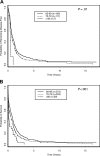Pretreatment cytogenetics add to other prognostic factors predicting complete remission and long-term outcome in patients 60 years of age or older with acute myeloid leukemia: results from Cancer and Leukemia Group B 8461
- PMID: 16522815
- PMCID: PMC1895823
- DOI: 10.1182/blood-2005-11-4354
Pretreatment cytogenetics add to other prognostic factors predicting complete remission and long-term outcome in patients 60 years of age or older with acute myeloid leukemia: results from Cancer and Leukemia Group B 8461
Abstract
We investigated the relative prognostic significance of cytogenetics in 635 adult acute myeloid leukemia (AML) patients 60 years of age or older treated on front-line protocols. Classification trees and tree-structured survival analysis (TSSA) were used to identify important cytogenetic groups, and their prognostic significance was then assessed in multivariable analysis (MVA). Overall, 48.5% achieved complete remission (CR); 6.6% survived at 5 years. Complex karyotypes with at least 3 abnormalities (complex > or = 3) and a group including "rare aberrations" predicted lower CR rates (25% and 30%) versus other patients (56%). Compared with complex > or = 3, the odds of CR were significantly higher for noncomplex karyotypes without rare aberrations on MVA. Cytogenetically, complex > or = 5 predicted inferior disease-free survival on TSSA, remaining significant on MVA together with white blood cell count (WBC), sex, and age. For survival, complex > or = 5, rare aberrations, and core-binding factor (CBF) abnormalities were prognostic (P < .001), with 5-year survivals of 0%, 0%, and 19.4%, respectively, and 7.5% for remaining patients. Together with WBC, marrow blasts, sex, and age, the cytogenetic groups remained significant on MVA. In conclusion, pretreatment cytogenetics adds to other prognostic factors in older AML patients. Patients with complex > or = 5 appear to benefit minimally from current treatment and are better suited for investigational therapy or supportive care.
Figures





References
-
- Rathnasabapathy R, Lancet JE. Management of acute myelogenous leukemia in the elderly. Cancer Control. 2003;10: 469-477. - PubMed
-
- Wedding U, Bokemeyer C, Meran JG. Elderly patients with acute myeloid leukaemia: characteristics in biology, patients and treatment. Recommendations of the Working Group Geriatric Oncology of the German Society for Haematology and Oncology (DGHO), the Austrian Society for Haematology and Oncology (OGHO) and the German Society for Geriatrics (DGG). Onkologie. 2004;27: 72-82. - PubMed
-
- Whitman SP, Archer KJ, Feng L, et al. Absence of the wild-type allele predicts poor prognosis in adult de novo acute myeloid leukemia with normal cytogenetics and the internal tandem duplication of FLT3: a Cancer and Leukemia Group B study. Cancer Res. 2001;61: 7233-7239. - PubMed
-
- Leith CP, Kopecky KJ, Godwin J, et al. Acute myeloid leukemia in the elderly: assessment of multidrug resistance (MDR1) and cytogenetics distinguishes biologic subgroups with remarkably distinct responses to standard chemotherapy: a Southwest Oncology Group study. Blood. 1997;89: 3323-3329. - PubMed
-
- Moorman AV, Roman E, Willett EV, Dovey GJ, Cartwright RA, Morgan GJ. Karyotype and age in acute myeloid leukemia: are they linked? Cancer Genet Cytogenet. 2001;126: 155-161. - PubMed
Publication types
MeSH terms
Grants and funding
LinkOut - more resources
Full Text Sources
Other Literature Sources
Medical

